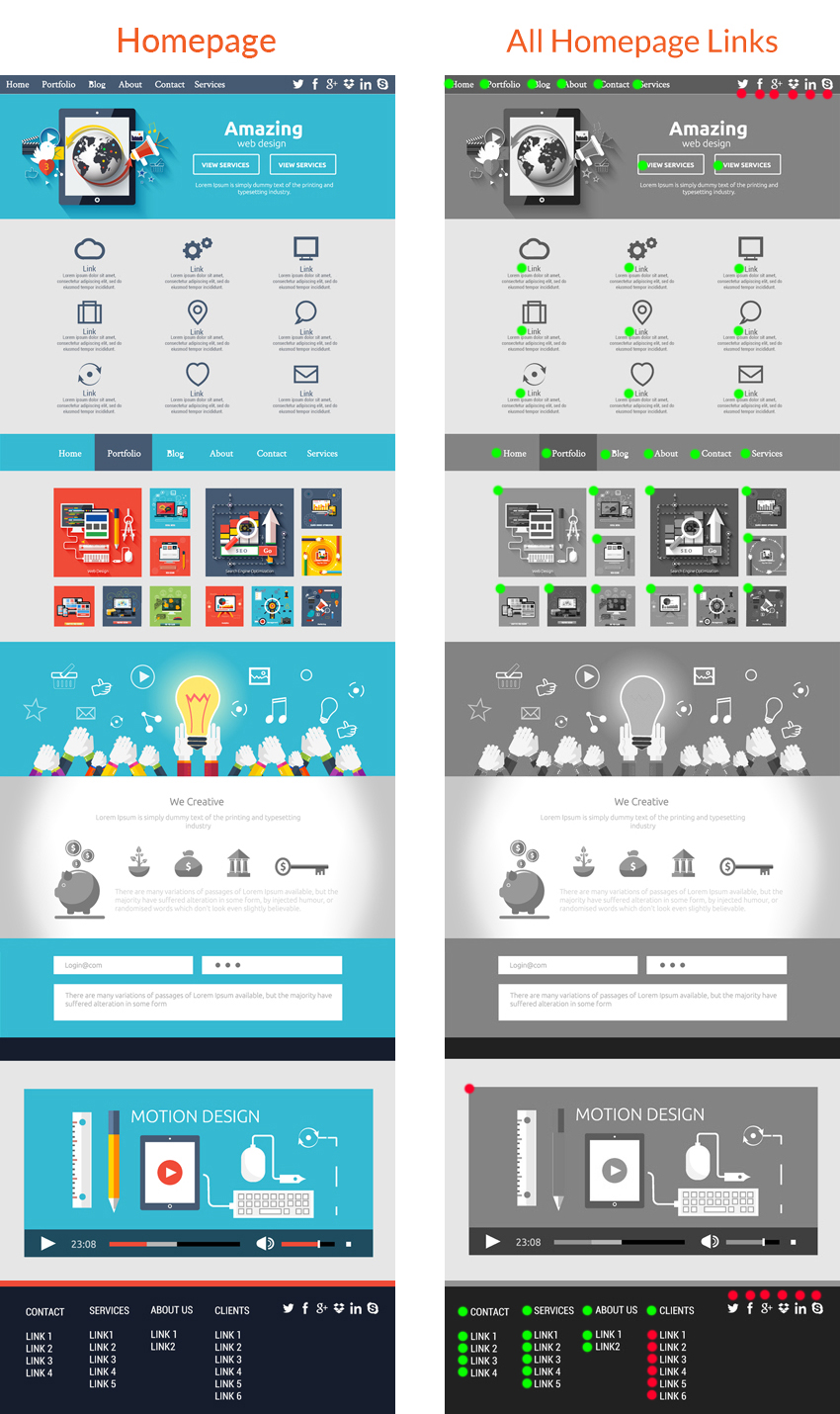
When looking for a website builder you should take the same things into consideration that you would if looking for a manual builder:
All too often, companies pay for a new website that looks amazing but isn’t designed with SEO in mind and therefore isn’t built with the right foundations to ensure it stands the test of time and performs online. Your website should be beautiful on the front end and thoughtfully constructed on the backend.
A website should be so much more than just visually appealing; granted, this is a crucial factor and design should always be a key consideration but in order to deliver a quality website, a web designer should always have 8 key considerations:
1. Design / Aesthetics
‘38% of people will stop engaging with a website if the content/layout is unattractive’. (Source: Adobe) The design of your website needs to be aesthetically pleasing in order to pique the user’s interest within the first few seconds of landing on your site. Having a bland outdated design, results in high bounce rates and reduced traffic. Additionally, the aesthetic of your website subconsciously communicates value and trustworthiness to your user base. Have you ever seen a website that was designed poorly and thought twice about purchasing a product from there? Your website design should be well thought out and visually pleasing to align with the impression you want to give off.
2. Branding
A website is the main point of reference for a company or organisation, which is why it’s imperative that the branding is clearly defined and in accordance with established brand guidelines. The consistency of company colours, and logo styles not only looks professional, but this consistency will make your brand fingerprint more memorable and distinct. This way, no matter where users are being referred from, they will instantly recognise the brand. This recognition could translate to more conversions as 71% of consumers are more likely to buy from a brand that they recognise.

3. SEO and ongoing performance
This article is going to focus on the structure of a homepage and how that should be designed with SEO in mind in order to predetermine how much value is passed to each internal page. However, there are many factors that should be taken into consideration to ensure that a website is structured to perform well in search engines. A beautifully designed and intuitive website will not drive conversions in itself unless a search engine identifies it as relevant and directs traffic towards it. A strong SEO foundation is therefore essential to the functioning of any website as it ensures that a website is structured to perform well in search engines. This strategy will ensure that when customers type in keywords that are relevant to your business, your website is likely to show up.

4. UX
User experience is an important process, whereby the user’s journey once on your website is analysed and enhanced to improve navigation and the overall experience/ease of use. Several factors determine a positive user experience. For example, the ease of navigation, determined by how many links are in the main navigation and their hierarchy, and the intuitiveness of main navigation titles; if a customer wanted to find a webpage, it shouldn’t be under a main navigation title that is obscure or unclear. Website design should attempt to create a user experience that is easy, intuitive, and oriented towards the goals of the website. For example, if you are offering a subscription service, integrate links to it throughout the webpages, and insert a subscription section on the home page. ‘88% of online consumers are less likely to return to a site after a bad experience.’ (Source: Gomez)
5. Longevity
Inevitably, every website will require updates in order to stay current, but every website should be designed with the future in mind. A website should be seen as an investment, that will continue to deliver ROI for the foreseeable future. The longevity of a website relies heavily on our next point, the ease of updates and CMS (content management systems).

6. Maintenance & Updates
Before investing in a new website, it’s important to make sure that it will be built with a Content Management system (i.e. Joomla or Wordpress) system that will be easy to access and use after completion. Web designers that build websites using their own CMS sometimes restrict the client from making updates independently in the future, often resulting in a permanent tie to the web design company.
To ensure you have full control of your website and are able to make updates as and when you need, without associated costs, you need to ensure that your website provider is using a Content Management System and that they are able to provide you with training.
7. Security

It’s important to work with a company that appreciate how important the security of your website is.
The best way to ensure that your website provider will take all of the above into consideration, is to choose a digital company that offers multiple services; this way you can rest assured that they have the knowledge and expertise to recognise and service all of the above, resulting in a website that will perform and compete online.
8. Responsive
With the large majority of internet users now using multi-platform devices, ensuring your website is responsive is more important than ever. Unresponsive web pages increase bounce rates. Internet users are not very patient because the internet is infinitely vast, and there is nothing more frustrating than landing on a website that crops off half the page, distorts the images and is barely readable; chances are you aren’t going to stay on the site for long, or have a very good impression of the company the site belongs to. A good website design company can ensure that your page is optimised for responsiveness. If you want to do a quick test to see how your website appears on different devices, just follow the steps in the video below:
Structuring a Website with Strong SEO Foundations
When you’re building a new website, it can be very easy to get carried away with the aesthetics of the design, but there is so much more to building a strong website than just design. A website build needs to combine thoughtful frontend design with equally thoughtful, and robust backend construction.
SEO (Search Engine Optimisation) should be a primary consideration in every website build. Think of your dream car, whether it’s a Ferrari or a Lamborghini, you are first drawn in by its stunning exterior. However, the aesthetics of the car only make up part of its appeal. It’s a combination of the bodywork and the powerful engine that gives these cars their reputation. Imagine buying a Bugatti with a 1L engine and faulty mechanics; it wouldn’t exactly live up to your expectations in terms of functionality. Websites are essentially the same: web design is the bodywork and SEO is the engine that keeps it running and serving its purpose. There are so many factors that need to be taken into account when it comes to SEO influenced website builds, so we’re going to cover just one of these: link dilution.
Link Dilution Reduces The Value of Webpages
Link dilution is when the value of a website is reduced when too many external links are included. If a large proportion of links direct the user away from your website and not within the website, then conversions are less likely to happen. Ensuring that link dilution does not occur is most vital on high value webpages, the pages that users are most likely to navigate to. Webpage value decreases the further in the navigation it appears, and the number of clicks away it is from the main home navigation. If you think of a website as a funnel, the value of traffic is diluted the further into a website you get, so although you may have had 50 visits to your homepage in one day, all of these users will have then taken a different journey on your site and maybe only 2 ended up visiting your contact page.
The Value of The Home Page
Taking link dilution into account, when users search a keyword or specific term that is relevant to your site, they are most likely to land on your home page, therefore this is where the majority of value lies. Now think about the structure of your homepage and the number of links you have included. Links are unquestioningly an essential part of a website, but they need to be carefully considered and mapped out in order to disperse value wisely, and not waste it.
How To Avoid Link Dilution
One way to maximise link value is by adjusting the proportion of internal links (links to your other webpages) compared to external links (links to other websites). Increasing the proportion of internal links encourages users to stay on your website, and therefore increases the chances of conversion.

The homepage example above contains multiple links, which at first glance may not seem to be of great importance, but when you look at these links in more depth you can highlight which are internal and which are external. The greyed out copy of the homepage on the right indicates the internal links with a green dot and the external links with a red dot.
There’s a total of 69 links on the homepage, 19 of which are external links. This means that 28% of the value being passed to the homepage is being handed out to external sites rather than being passed through your own site. We’re not suggesting that you don’t include any external links, just that you’re selective with those you choose and where you place them. For example, we can get rid of 13 external links from this page quite easily, leaving only 11% of the SEO value being passed externally. The links that we could easily remove to improve link dilution are as follows:
Find out more about the importance of SEO in web design and site structure from our Digital Director, Mike Bunn: